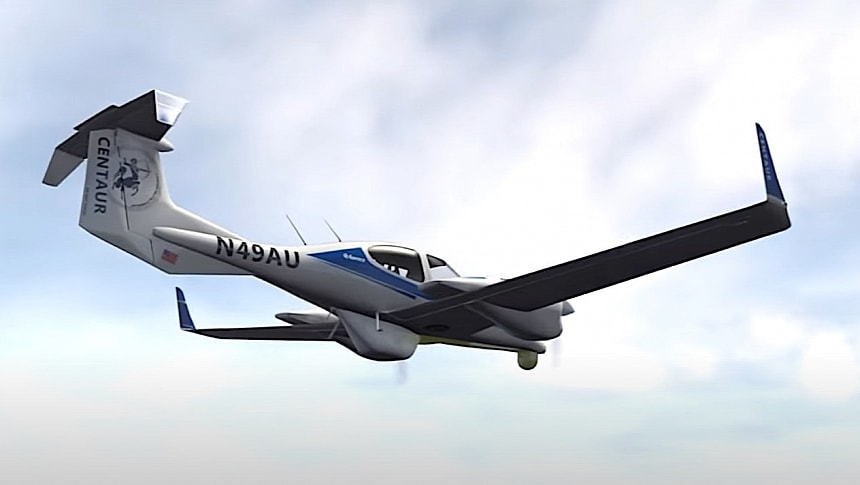We generally tend to think about aircraft in a binary way, at least when it comes to how they are operated: you either have piloted aircraft, or uncrewed ones, and that's about it. But there is another option on the table, a sort of hybrid between the two: the optionally piloted aircraft.
The OPA, as it's also called, have been designed to accommodate humans on board and allow them to take control, if need be, but they can also be operated from afar, like a drone. True, not many such aircraft are around, but research into them is accelerating, and it's probably a matter of time until we see more and more of them take to the sky.
One of the companies working to make OPAs commonplace is Boeing's Aurora Flight Sciences. A common name in the world of experimental aircraft (the company is involved in several DARPA projects at the moment), Aurora is working for some time now with something called the Centaur.
The machine is a Diamond DA42 aircraft, which its maker describes as easy to fly as a single but with the added safety of a second engine. In its normal configuration, the aircraft can transport a total of four people at speeds of up to 227 mph (365 kph) and to distances of some 1,400 miles (2,250 km).
Aurora's DA42 is significantly different from stock. The plane was purpose-designed to act as a test bed for the various technologies Aurora is currently developing (including for other experimental aircraft), but also as a trainer to teach student pilots the ins and outs of operating an uncrewed aircraft.
We brought the plane up today because Aurora announced it conducted a test flight with the thing in the National Airspace System (NAS). This was possible because a backup pilot was on board while the plane was being controlled from a ground station as it flew from Manassas, Virginia, to the Potomac River.
The goal of the flight was to test several technologies and capabilities, including the data link quality in bad weather at altitudes ranging from 4,500 to 7,500 feet (1,370 to 2,280 meters).
During the flight the plane was controlled by two people on the ground, while the third was in the cockpit, ready to take control should anything go wrong. The plane's mission was to snap pics using an EO/IR camera and send them back to its control station. During the test, the Centaur also carried a maritime surveillance radar with it.
Now that test flights with a pilot on board and controllers on the ground in the NAS have successfully been made, Aurora plans to use the Centaur to test various tech by flying it from airports instead of remote locations.
The tech that's being developed during these flights can potentially be used in multiple areas, including defense, intelligence, law enforcement, and environmental research.
One of the companies working to make OPAs commonplace is Boeing's Aurora Flight Sciences. A common name in the world of experimental aircraft (the company is involved in several DARPA projects at the moment), Aurora is working for some time now with something called the Centaur.
The machine is a Diamond DA42 aircraft, which its maker describes as easy to fly as a single but with the added safety of a second engine. In its normal configuration, the aircraft can transport a total of four people at speeds of up to 227 mph (365 kph) and to distances of some 1,400 miles (2,250 km).
Aurora's DA42 is significantly different from stock. The plane was purpose-designed to act as a test bed for the various technologies Aurora is currently developing (including for other experimental aircraft), but also as a trainer to teach student pilots the ins and outs of operating an uncrewed aircraft.
We brought the plane up today because Aurora announced it conducted a test flight with the thing in the National Airspace System (NAS). This was possible because a backup pilot was on board while the plane was being controlled from a ground station as it flew from Manassas, Virginia, to the Potomac River.
The goal of the flight was to test several technologies and capabilities, including the data link quality in bad weather at altitudes ranging from 4,500 to 7,500 feet (1,370 to 2,280 meters).
During the flight the plane was controlled by two people on the ground, while the third was in the cockpit, ready to take control should anything go wrong. The plane's mission was to snap pics using an EO/IR camera and send them back to its control station. During the test, the Centaur also carried a maritime surveillance radar with it.
Now that test flights with a pilot on board and controllers on the ground in the NAS have successfully been made, Aurora plans to use the Centaur to test various tech by flying it from airports instead of remote locations.
The tech that's being developed during these flights can potentially be used in multiple areas, including defense, intelligence, law enforcement, and environmental research.









